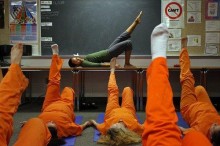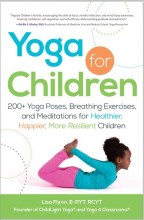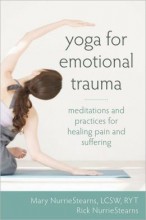 I love reading new studies that corroborate what those of us who practice yoga experience directly. We know how much better we feel afterwards. Those of us who teach see first-hand the effect of what we offer our students. I’ll never forget the first time I taught at the juvenile detention center in Tucson. The girls shuffled in, numb, faces flattened by following the rules, by medication, over-fed on carbs, and under appreciated. How lit up they were when the class was over, wanting to share thoughts and feelings with me. It was a transformational experience for me–a true knowing that I had found my dharma, my reason to be in this body at that moment in time. I didn’t need studies to prove the effects on them or on me. But now we have many studies. As Stephanie Shorter’s article points out, research on yoga is growing exponentially. If anyone is contemplating a research project, please don’t hesitate to contact us for support. We can offer you materials and consult with you on your protocol. http://yogafordepression.com/for-researchers/
I love reading new studies that corroborate what those of us who practice yoga experience directly. We know how much better we feel afterwards. Those of us who teach see first-hand the effect of what we offer our students. I’ll never forget the first time I taught at the juvenile detention center in Tucson. The girls shuffled in, numb, faces flattened by following the rules, by medication, over-fed on carbs, and under appreciated. How lit up they were when the class was over, wanting to share thoughts and feelings with me. It was a transformational experience for me–a true knowing that I had found my dharma, my reason to be in this body at that moment in time. I didn’t need studies to prove the effects on them or on me. But now we have many studies. As Stephanie Shorter’s article points out, research on yoga is growing exponentially. If anyone is contemplating a research project, please don’t hesitate to contact us for support. We can offer you materials and consult with you on your protocol. http://yogafordepression.com/for-researchers/
Read on for reviews of several new books for children and adults that can make a difference in our lives.
- Research: Yoga Improves Mood and Manages Behavior in Prison
- Research: Research Roundup
- Review: Mindful Yoga Therapy for Veterans Recovering from Trauma by Suzanne Manafort & Daniel J. Libby, Ph.D.
- Review: Yoga for Children by Lisa Flynn
- Review: Yoga for Emotional Trauma: Meditations and Practices for Healing Pain and Suffering by Mary and Rick NurrieStearns
- News: Yoga Pilgrimage to India February 18-March 9, 2014
- News: A Successful Program for School Children in Israel
- News: LifeForce Yoga Practitioner Training in Tucson Early Bird
- News: LifeForce Yoga Practitioner Training in Three Modules
- Events Calendar
Research: Yoga Improves Mood and Manages Behavior in Prison
Years ago, while teaching weekly yoga classes at the Juvenile Detention Center in Tucson, there seemed to be so much mood improvement that we conducted a study that was published in an early International Association of Yoga Therapists publication. Now, a large trial in the United Kingdom has shown that yoga can improve mood and mental wellbeing among prisoners, including those in juvenile detention, and may also have an effect on impulsive behavior.
The Oxford University researchers found that after a ten-week yoga course, prisoners reported improved mood, reduced stress and were better at a task related to behavior control than those who continued in their normal prison routine.
‘We found that the group that did the yoga course showed an improvement in positive mood, a decrease in stress and greater accuracy in a computer test of impulsivity and attention,’ say Dr Amy Bilderbeck and Dr Miguel Farias, who led the study. Dr Bilderbeck adds: ‘Offering yoga sessions in prisons is cheap, much cheaper than other mental health interventions. If yoga has any effect on addressing mental health problems in prisons, it could save significant amounts of public money.’
The researchers were supported in the running of the trial by the Prison Phoenix Trust, an Oxford-based charity that offers yoga classes in prisons. They approached the Oxford University psychologists about conducting such a study to assess the benefits, though the study was designed, analyzed and published independently of the Trust.
The Oxford University researchers, along with colleagues from King’s College London, the University of Surrey and Radboud University Nijmegen in the Netherlands, report their findings in the Journal of Psychiatric Research.
Prisons see rates of mental health problems that are many times higher than the general population, and high levels are often recorded of personal distress, aggression, antisocial behavior and drug and alcohol abuse among prisoners.
Inmates of a range of ages were recruited from five category B and C prisons, a women’s prison and a young offender institution, all in the West Midlands, and were randomly assigned to either a course of ten weekly yoga sessions of 90 minutes run by the Prison Phoenix Trust, or to a control group. In sessions with the researchers before and after the yoga course, all the prisoners completed standard psychology questionnaires measuring mood, stress, impulsivity and mental wellbeing. A computer test to measure attention and the participant’s ability to control his or her responses to an on-screen cue was also used after the yoga course.
If yoga is associated with improving behavior control, as suggested by the results of the computer test, there may be implications for managing aggression, antisocial or problem behavior in prisons and on return to society, the researchers note – though this is not measured in this initial study.
Dr Bilderbeck, who practices yoga herself, cautions: ‘We’re not saying that organizing a weekly yoga session in a prison is going to suddenly turn prisons into calm and serene places, stop all aggression and reduce re-offending rates. We’re not saying that yoga will replace standard treatment of mental health conditions in prison. But what we do see are indications that this relatively cheap, simple option might have multiple benefits for prisoners’ wellbeing and possibly aid in managing the burden of mental health
problems in prisons.’
Sam Settle, director of the Prison Phoenix Trust, says: ‘Almost half of adult prisoners return to prison within a year, having created more victims of crime, so finding ways to offset the damaging effects of prison life is essential for us as a society. This research confirms what prisoners have been consistently telling the Prison Phoenix Trust for 25 years: yoga and meditation help them feel better, make better decisions and develop the capacity to think before acting – all essential in leading positive, crime-free lives once back in the community.’
To read the article in full please click here.
J Psychiatr Res. 2013 Jul 15. pii: S0022-3956(13)00197-0. doi: 10.1016/j.jpsychires.2013.06.014. [Epub ahead of print] “Participation in a 10-week course of yoga improves behavioural control and decreases psychological distress in a prison population.” Bilderbeck AC, Farias M, Brazil IA, Jakobowitz S, Wikholm C.
Research: Research Roundup
Stephanie Shorter, PhD, has an article about the junction of yoga research and yoga service in which she says that yoga research has increased by 10-fold in the last few decades. To read the article in the Journal of Yoga Service, click here. It’s on page 15.
Review: Mindful Yoga Therapy for Veterans Recovering from Trauma by  Suzanne Manafort & Daniel J. Libby, Ph.D.
Suzanne Manafort & Daniel J. Libby, Ph.D.
Reviewed by Deborah E. Lubetkin, Psy.D., RYT-200, LFYP 2 & Mentor
Authors Suzanne Manafort, ERYT-500 and Daniel Libby, Ph.D. have joined forces to create an accessible yoga practice for veterans dealing with Post-Traumatic Stress (PTS) and Post-Traumatic Stress Disorder (PTSD). The 65-page manual includes 2 cd’s, “Breathe In, Breathe Out” and “Deep Relaxation: Yoga Nidra,” as well as an illustrated Practice Guide (poster) demonstrating each asana or physical posture. Based on the philosophy of Embodyoga, the Mindful Yoga Therapy practice is grounded in the principle that “support precedes action in asana and in life.” The authors emphasize the following supports throughout the program: acceptance, breath, a calm and supported spine, full body postures, navel support, and the concept of “yield” or grounding. Further, they view the role of psychotherapy as playing an additional and important role in supporting this practice to aid veterans in their recovery from post-traumatic stress (PTS).
With a gentle, understandable and non-judgmental explanation of the syndrome of Post-Traumatic Stress, the authors immediately create a container of support for veterans to learn about PTS in the privacy of their own environment. The philosophy of why yoga works is also aptly described, helping to remove any obstacles or preconceptions about yoga that beginners may hold. While the breath practices are described in the manual in detail, the instructions on the CDs are at times less clear, so it is essential to read the manual in its entirety prior to utilizing the CDs. There are also times of long silences which, for some veterans could be difficult to sustain without the safety and constancy of being anchored to someone’s voice. Finally, the yoga nidra practice could be a fuller experience, flowing through all of the koshas as in the more traditional Yoga Nidra practices. Instead, the Yoga Nidra practice is quite short in length and missing some of the essential elements that help to make the practice of Yoga Nidra so effective for veterans with PTSD. The asana practice is rich and well-illustrated, with both pictures and verbal instructions in the manual to further aid easeful transition into the postures. Once the postures and breath practices are mastered, one can just utilize the poster to move through the sequence.
Overall, the Mindful Yoga Therapy program is a wonderful beginning resource for Veterans experiencing symptoms of PTS and PTSD. It is also a portal in to the world of yoga and pranayama, creating potential for the further exploration of yoga and yogic principles in the lives of our Veterans.
Mindful Yoga Therapy for Veterans Recovering from Trauma is a collaborative endeavor between The Veterans Yoga Project and the Give Back Yoga Foundation.
To purchase a copy of Mindful Yoga Therapy for Veterans Recovering from Trauma click here.
Deborah Lubetkin is a Licensed Psychologist and Certified Kripalu Yoga teacher. In her private practice of over 18 years, Deborah creates an integrative forum for her clients to empower themselves in creating integrative treatment plans to address a wide variety of mood-related imbalances.
Review: Yoga for Children by Lisa Flynn
Reviewed by Ellen Campbell, LifeForce Yoga Practitioner, Hatha Yoga Instructor and author of The Youthful Yogis Blog.
Wander through any bookstore or peruse most online bookseller sites and chances are you will find an abundance of excellent reference materials on the subject of yoga. However, uncovering a comprehensive yoga guide for children and pre-teens can be a much greater challenge… until now! Lisa Flynn’s inviting new book, Yoga for Children (published by Adams Media) offers a thorough and accessible guide to practicing yoga with kids.
The book begins with an overview of the origins of yoga and then touches upon some of the significant philosophical underpinnings of this ancient tradition. Ms. Flynn offers helpful suggestions for introducing the Principles of Yoga to children of every age. Indeed, one of the many strengths of Lisa Flynn’s work is her ability to highlight the stages of childhood development and to offer talking points, breath work, poses, props and games wonderfully suited to each specific age. Lisa Flynn is the founder of “ChildLight Yoga” and “Yoga 4 Classrooms”. You can visit her website at www.childlightyoga.com.
Yoga for Children has much to offer: succinct instruction on a variety of poses, songs, visualizations and games. Readers even learn how to mix their very own “Magic Mist!” Lisa Flynn’s book will be a welcome addition to the reading library of every adult interested in sharing the joy of yoga with children. And, thanks to the book’s friendly tone and colorful layout, it is sure to be a favorite on kids’ bookshelves as well!
To order Yoga for Children, please click here.
Review: Yoga for Emotional Trauma: Meditations and Practices for Healing Pain and Suffering by Mary and Rick NurrieStearns
The authors of Yoga for Anxiety have brought us a beautiful book of healing yoga practices for trauma survivors. Not only do they include their own inspiring stories of coming to yoga and meditation to heal, but their prose is full of anecdotes to which readers can readily relate. The NurrieStearns include selfinquiry practices, easy-to-follow guided meditations that anchor the mind with concentration techniques and breath. From the start of the book, the reader is helped to develop an attitude of self-compassion and, the practices, be they postures or simple breathing, are offered with ways to accept yourself as you begin.
In clear and readable prose, the NurrieStearns explain the brain science behind the effects of trauma and how the brain changes with yoga and meditation. My only quibble with this manual of practices, which I do consider essential reading for anyone with a history of trauma, is that the first chapter dives directly into cultivating compassion. Developing compassion for oneself is often the most challenging job for anyone with a history of abuse. The suggestion of selecting a quote or recalling a memory of someone being kind to you may not be sufficient to overcome the strong negative self-talk, self-blame and rumination that often accompanies trauma. While the authors’ suggestions are excellent, in this reviewers opinion, they would better serve the reader if they were introduced later in the book, after some of the physical and breath practices have helped clear away the mind’s distracting thoughts. After a pranayama breathing practice, for example, it is easier for most of us to catch a glimpse of who we are beyond whatever mood is visiting or whatever story we are telling ourselves about our trauma. It is in these moments of expanded awareness that the seeds of compassion can be most effectively nourished. However, don’t neglect this book, just because I think the order might have been different. It’s worthwhile reading for us all.
Accompanying most every suggested practice, there is a helpful section on the science of how the practice effects the body-mind. Whether you come to Yoga for Emotional Trauma for your own healing or because you serve others who suffer from the effects of trauma, keep it near you for inspiration and knowledge.
To purchase a copy of Yoga for Emotional Trauma: Meditations and Practices for Healing Pain and Suffering please click here.
News: Yoga Pilgrimage to India February 18-March 9, 2014
I am often asked if I would lead a trip to India. This is not going to happen anytime soon, but I am happy to tell you about my friends Dr. Mehrad Nazari and author Michele Hébert, experienced group leaders whom I trust to take you on the India journey of your life. Michele and Mehrad are master yoga teachers and have been teaching Raja Yoga and meditation for over 30 years. They have traveled throughout India many times since 1996 and studied with mystics, sages and saints including Swami Veda Bharati, Himalayan Master. During this transformative trip, receive first-hand experience of ashram living as well as an exceptional 5-star cultural tour highlighting some of India’s foremost sacred sites. For more information visit http://www.rajayogis.net.
News: A Successful Program for School Children in Israel
One of the pleasures of gathering with yoga colleagues at the International Association of Yoga Therapists annual conference, the Symposium on Yoga Therapy and Research (SYTAR) is learning about impressive yoga programs that have transformed the lives of people within the communities they serve. I learned about the Mindful Language program in the Tel-Hai School in Israel from its founder, Dr. Nimrod Sheinman, when we shared an outdoor cupola to eat our box lunch.
There are lots of yoga-based and mindfulness-based school programs in the US, but none that I’m aware of is so well constructed that one hour a week can make such a difference in a child’s academic achievement, self-awareness, and compassion towards self and others. The results of the Mindful Language program have been so impressive that Richard Davidson, the researcher known for his brain imaging studies of Tibetan monks and other meditators and his colleagues from the University of Wisconsin came to observe the program. This article, originally written in Hebrew, was translated into English and is downloadable here: http://mindbody-il.com/mind-body_children.html
The article describes the program and its benefits to the Tel-Hai School. Here’s a brief excerpt from the article:
The “Mindful Language” program managed to integrate these principles [Nondual] and to adapt them to kids and to the school framework. When the children are lying down relaxed, or as Shalem defines it “When the body is soft like a well cooked spaghetti”, Shalem guides them to count their breaths, to pay attention to their inner sensations and to notice the position of their body in space. “Imagine the throat is like an elevator, from which we can go down to the heart”, says Shalem, and asks them: “What is happening down there now? What is happening in your throat? What is it like in the area of your shoulders? And what’s happening around your heart?” The children are instructed to notice what part of their body asks for touch, and to reach it with their warm palms. Afterwards, they place their warm hands on their eyes, “Invite your eyes to rest, and feel confident in the class”. Then, they place their hands on their ears, “Listen to the inner sea”. They are invited to position their hands on their heart region, and to explore how they feel right now. “What kind of expression does the face of your heart have today?” Shalem asks them…
…In the course of the lesson, they will also be instructed to stand up “like a mountain”, to feel tall and grounded “like a tree”, and to move with awareness according to various visual images. The class ends with a body scan and guided imagery accompanied by music. …
…Dr. Nimrod Sheinman explains: “Through the mindfulness and imagery practices, the kids develop attention and awareness skills. They learn to notice their inner world, including the pleasant and unpleasant sensations and feelings. Consciously and unconsciously, they learn to take a “Mindful Pause” and to contain their discomforts rather than automatically react
to them….”
If you’re interested in this program feel free to write the founding director, Nimrod at nimush@zahav.net.il.
News: LifeForce Yoga Practitioner Training in Tucson Early Bird
Join us in Tucson, January 12 – 19, 2014, for the LifeForce Yoga Practitioner Training – Level 1, for yoga teachers, therapists and other mental health professionals. Participants will experience evidence-based practices for mood management. Each day begins with an early morning practice of yoga, meditation, breathing practices and chanting. The day continues with two 3 hour sessions with a midday break to enjoy the warm Arizona desert or get a message.
Registration details
Prerequisites
News: LifeForce Yoga Practitioner Training in Three Modules
The LFYP training is also available in three modules. Module A will be taking place at Sivananda Ashram in The Bahamas February 6 – 10, 2014. Module A is experiential and open to all. Participants will experience all aspects of LifeForce Yoga in a retreat setting on the beach.
Module B is online learning. You will participate in five webinars designed to give you a foundation in LifeForce Yoga. The topics covered are: Creating the Safe Container, Mantra & Mudra, Pranayama, and Trauma. Module B is scheduled for October, 2013 and may be taken before Module A.
yogafordepression.com/modular-practitioner-training
Events Calendar
Click the link above to browse our upcoming workshops and training opportunities!